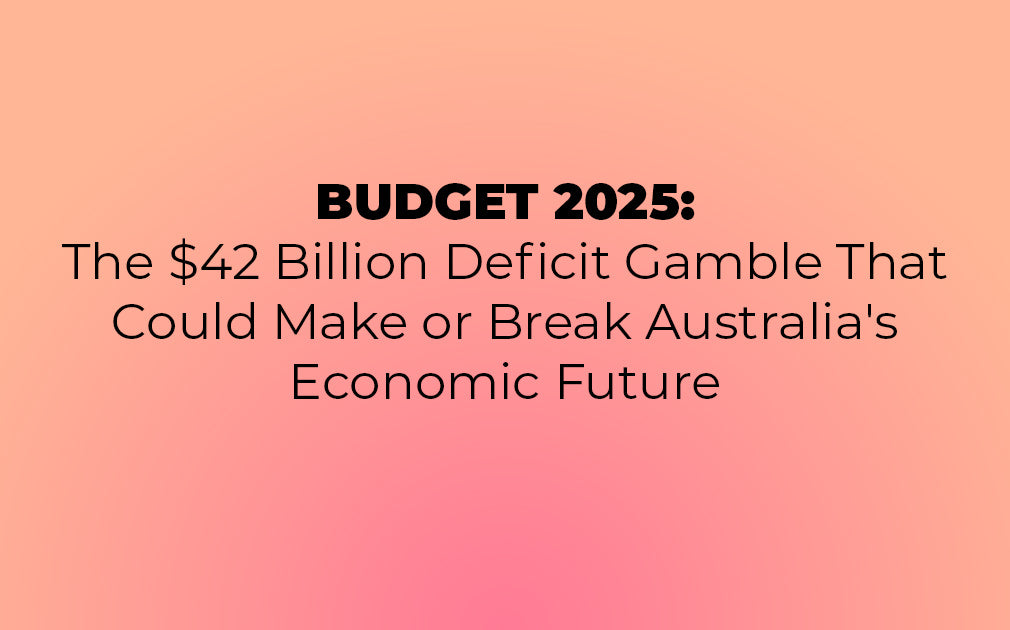In a high-stakes move that will reverberate through every Australian household and business, Treasurer Jim Chalmers has unveiled a federal budget that walks a precarious tightrope between immediate economic relief and long-term fiscal sustainability. The $17 billion income tax cut package and $8.5 billion Medicare overhaul headline a budget clearly designed with an impending election in mind, yet the accompanying $42 billion deficit projection for 2026 raises profound questions about Australia's economic trajectory at a critical global juncture.
As international pressures mount from rising protectionism, climate-driven disasters, and persistent inflation, this budget represents nothing less than a calculated gamble on Australia's economic resilience. The decision to prioritise cost-of-living relief through targeted spending rather than structural reform signals a defining philosophical approach to governance that voters will soon judge at the ballot box. With significant implications for everything from housing affordability to industrial competitiveness, the 2025-26 budget deserves forensic examination beyond the headline figures.
The unusual timing of this budget – delivered in March rather than the traditional May – itself speaks volumes about its political dimension. Releasing fiscal projections closer to an anticipated election provides the government maximum opportunity to frame economic narrative while giving opposition forces less time to develop counter-proposals. This strategic positioning comes as households continue battling elevated interest rates, energy costs, and housing pressures despite technical economic growth.
The Tax Relief Equation: Winners, Losers, and Long-Term Implications
The centerpiece $17.6 billion tax relief package delivers its benefits through a reduction of the first tax bracket rate from 16% to 14%, a targeted approach that ensures virtually all taxpayers receive some benefit while providing proportionally greater relief to lower and middle-income earners. This structure represents a distinct philosophical departure from the previous administration's Stage 3 tax cuts, which delivered larger dollar benefits to higher-income Australians.
For the average worker earning $79,000 annually, the tax changes translate to approximately $268 in reduced tax liability in 2026 and $536 the following year – modest amounts that nonetheless provide tangible household budget relief. The government projects these measures will boost real household disposable income by approximately 9% by 2026-27 compared to 2023-24 levels, creating a consumption-led growth buffer against potential economic headwinds.
Economic analysts remain divided on whether this approach represents sound fiscal management or election-year expediency. "These tax adjustments deliver immediate relief without addressing the structural issues in our tax system that create bracket creep and distortionary effects across the economy," notes independent economist Maya Richardson. "While politically savvy, they represent another missed opportunity for comprehensive tax reform that successive governments have avoided for decades."
The budget's MYEFO (Mid-Year Economic and Fiscal Outlook) projections paint a concerning longer-term picture, with deficits forecast at $35-42 billion annually over the forward estimates period beginning 2025-26. While net government debt reaching $768 billion by 2028-29 (23.1% of GDP) represents a significant improvement from projections three years ago, the structural deficit suggests limited fiscal capacity to respond to future economic shocks without more substantial revenue measures or spending constraints.
Healthcare Transformation: The $8.5 Billion Medicare Revolution
The government's $8.5 billion healthcare package represents the most substantial reform to primary care delivery in decades, centered around making general practitioner services more affordable and accessible. The initiative aims to address growing concerns about the declining availability of bulk-billing practices and mounting out-of-pocket costs that have forced many Australians to delay necessary medical care.
Core elements of the healthcare package include:
-
Enhanced Medicare rebates for GP consultations to incentivise longer patient appointments and comprehensive care
-
Expanded bulk-billing incentives targeting areas with demonstrated healthcare access challenges
-
Funding for digital health infrastructure to improve continuity of care and reduce administrative burdens
-
Support for multidisciplinary team-based care models that integrate allied health services into primary care settings
The healthcare reforms reflect both immediate electoral considerations and legitimate policy concerns about Australia's aging population and growing chronic disease burden. Public health experts generally welcome the increased investment while questioning whether the measures go far enough to address fundamental structural challenges in healthcare delivery.
"This package represents meaningful progress toward a more accessible primary care system," acknowledges healthcare policy specialist Dr. Eleanor Simmons. "However, the question remains whether these funding increases will be sufficient to reverse the long-term trend of declining GP workforce participation and practice viability, particularly in regional and disadvantaged communities."
The budget allocates additional healthcare funding toward mental health services, aged care quality improvements, and preventative health programs – all areas that showed significant vulnerabilities during the pandemic period. These investments align with expert recommendations for healthcare system resilience but fall short of the comprehensive restructuring many industry leaders have advocated.
The Housing Conundrum: Addressing Affordability in a Supply-Constrained Market
Housing affordability continues to represent one of Australia's most intractable economic challenges, with the budget offering incremental rather than transformative solutions. The government has confirmed expansion of its Help to Buy shared equity scheme, allowing eligible first-home buyers to purchase property with smaller deposits while the government maintains an equity stake in the dwelling.
The budget contains approximately $850 million in direct housing spending focused primarily on first-home buyers, a relatively modest amount compared to the $33 billion the government claims to have invested in housing since taking office three years ago. Notable housing-related measures include:
-
Expansion of the Help to Buy shared equity scheme with adjusted price caps for eligible properties
-
Extension of Regional Home and Family Home Guarantees for another four years
-
Funding for social and affordable housing construction through existing National Housing Accord mechanisms
-
Limited incentives for build-to-rent developments to increase the rental housing supply
Property economists express skepticism about whether these measures adequately address the fundamental supply-demand imbalance driving housing unaffordability across major metropolitan areas. "The budget continues Australia's long tradition of demand-side interventions that may assist individual buyers but risk further inflating property values without corresponding supply increases," observes housing researcher Dr. Jonathan Chen.
The absence of more substantial Commonwealth-state coordination on planning reform, infrastructure provision, and construction industry productivity improvements represents a missed opportunity to address systemic housing market dysfunction. While politically sensitive, these structural factors remain the primary barriers to meaningful housing affordability improvements for most Australians.
Energy and Climate: Navigating the Transition Amidst Cost Pressures
Energy policy emerges as another area where immediate cost-of-living pressures have shaped budget priorities, with the government extending $150 energy rebates for an additional six months at a cost of $1.8 billion. This temporary measure addresses symptom rather than cause of energy market volatility, buying time while longer-term transition investments mature.
The climate and energy components of the budget build upon the previously announced $22.7 billion Future Made in Australia (FMIA) policy framework, with an additional $3 billion allocated specifically toward domestic production of green aluminum and iron. This targeted investment acknowledges both the economic opportunity and necessity of decarbonising Australia's energy-intensive export industries in response to emerging carbon border adjustment mechanisms being implemented by major trading partners.
Other notable climate and energy budget components include:
-
$1.2 billion in funding for Queensland cyclone damage relief, reflecting growing climate disaster recovery costs
-
$57 million for Energy Efficiency Grants targeting small and medium enterprises
-
$20 million for a 'Buy Australia' campaign responding to rising international protectionism
-
Continued funding for renewable energy zones, transmission infrastructure, and community batteries
Climate policy experts note the budget strikes a pragmatic balance between addressing immediate energy affordability concerns and maintaining momentum on longer-term decarbonisation objectives. "The energy rebate extension acknowledges the real financial pain many households are experiencing, while the green industry investments signal commitment to positioning Australia competitively in a carbon-constrained global economy," notes energy transition analyst Dr. Amelia Nguyen.
Critics argue the budget lacks sufficient urgency given accelerating climate impacts and international policy developments. The absence of comprehensive fossil fuel subsidy reform, stronger carbon pricing mechanisms, or more substantial household electrification programs represents continued incremental rather than transformative climate policy despite mounting evidence of economic risks from delayed action.
Workforce Development and Productivity: Building Human Capital for Future Growth
Recognising that long-term economic prosperity depends on workforce skills and productivity, the budget makes permanent 100,000 free TAFE places annually to address critical skills shortages across priority sectors. This investment aims to address both immediate labor market gaps and position Australia's workforce for emerging industry opportunities in areas like renewable energy, advanced manufacturing, and digital services.
The budget's most significant labor market reform comes not through spending but regulatory change, with the government introducing restrictions on non-compete clauses for workers earning less than $175,000 annually. This measure, which economists broadly support, aims to enhance labor market dynamism, knowledge transfer, and wage growth by enabling greater worker mobility between employers.
"The non-compete clause reforms represent one of the budget's most economically significant measures despite their limited fiscal impact," explains labor economist Dr. Marcus Chen. "International evidence suggests reducing these mobility barriers can deliver productivity benefits comparable in scale to the announced tax cuts while simultaneously addressing wage stagnation concerns."
Other workforce-related budget initiatives include:
-
Extended support for apprenticeship completion incentives in priority industries
-
Funding for women's workforce participation initiatives and childcare accessibility
-
Investment in digital skills development programs and mid-career transition support
-
Regional workforce development strategies targeting areas with persistent skills gaps
Productivity experts generally welcome these measures while noting their modest scale relative to Australia's substantial workforce challenges. The budget stops short of more fundamental reforms to education systems, immigration settings, or workplace relations frameworks that could deliver more substantial productivity improvements over the longer term.
Business and Industry: Navigating Global Uncertainty and Domestic Challenges
For the business community, the budget delivers a mixed package that addresses some immediate concerns while leaving deeper structural issues largely untouched. Small businesses receive energy bill relief and targeted support measures, but the popular instant asset write-off program appears to have been allowed to lapse without replacement, a development generating significant concern among industry groups.
The $3 billion allocation for green manufacturing, particularly in aluminum and steel production, represents the government's most substantial industry policy intervention. This funding aims to position Australia competitively as major economies implement carbon border taxes that could disadvantage emissions-intensive exporters. While environmentally necessary, this transition creates significant challenges for regions and workers dependent on traditional manufacturing and resource sectors.
"The green industry funding acknowledges the reality that Australia must transform its industrial base to remain competitive in a decarbonising global economy," notes manufacturing industry analyst Dr. Rebecca Torres. "However, the scale of investment remains modest compared to programs being implemented by major competitors like the United States, European Union, and China."
Small business advocates express disappointment at the apparent discontinuation of the instant asset write-off program, which had provided significant investment incentives during challenging economic conditions. "Small enterprises facing rising input costs and interest rates relied on this program to maintain capital investment," explains small business federation spokesperson Michael Chen. "Its absence creates additional uncertainty at a time when business confidence remains fragile."
Fiscal Sustainability and Economic Management: The $42 Billion Question
The budget's headline $42 billion deficit projection for 2026 raises fundamental questions about Australia's fiscal trajectory and economic management philosophy. While significantly improved from pandemic-era projections, this continued structural deficit limits policy flexibility and potentially constrains future governments' ability to respond to economic shocks.
Economic commentators note that the unusual March timing of the budget announcement has potentially compromised the reliability of its economic forecasts. "By rushing the budgetary cycle to align with electoral considerations, the government has constrained the time available to incorporate the latest data on growth, inflation, and labor market developments," argues macroeconomist Dr. Jonathan Reynolds. "This creates additional uncertainty around revenue and expenditure projections that form the foundation of fiscal planning."
The budget projects inflation returning to the Reserve Bank's target band during the forecast period, creating conditions for potential interest rate relief. However, the expansionary nature of the budget – particularly its focus on consumption support through tax cuts and rebates – creates tensions with monetary policy objectives that may complicate the Reserve Bank's decision-making process.
"The fiscal stance embodied in this budget doesn't significantly ease the Reserve Bank's inflation management challenges," observes monetary policy specialist Dr. Sophia Zhang. "While targeted rather than broadly stimulatory, the additional household spending capacity created by tax cuts and rebates works against disinflationary forces, potentially delaying interest rate normalisation."
The budget's underlying economic assumptions appear generally reasonable but contain notable optimistic elements, particularly regarding productivity growth and terms of trade projections. These parameters significantly influence revenue forecasts and deficit projections, creating downside risks to the fiscal outlook if global conditions deteriorate or domestic productivity improvements fail to materialise.
International Context: Navigating a Fragmenting Global Economy
The budget's international economic assumptions reflect a world experiencing significant structural shifts in trade patterns, geopolitical alignments, and economic governance. Rising protectionism, particularly the potential return of tariff-focused trade policies in the United States, creates substantial uncertainties for Australia's export-oriented economy.
The $20 million allocation for a 'Buy Australia' campaign represents a modest defensive response to these international developments, aiming to support domestic producers increasingly competing against subsidised international alternatives. However, this represents a reactive rather than strategic approach to the fundamental restructuring of global trading relationships currently underway.
"Australia faces profound challenges navigating a fragmenting global economic order that increasingly operates on political rather than purely economic logic," explains international trade expert Dr. Eleanor Wong. "This budget acknowledges these realities but doesn't yet offer a comprehensive strategy for securing Australia's prosperity in a more fractious and protectionist global environment."
The budget's international economic projections assume relatively stable trading relationships with major partners, including China, Japan, and South Korea, while acknowledging heightened volatility in international financial and commodity markets. These baseline assumptions appear reasonable but potentially underestimate tail risks from more disruptive geopolitical developments or accelerated decoupling between major economic blocs.
Conclusion: Election Economics or Sound Policy?
As Australians digest the implications of the 2025-26 budget, the central question remains whether its measures represent sound economic management adapted to challenging circumstances or election-focused policies prioritising short-term political advantage over long-term national interest.
The truth likely incorporates elements of both perspectives. The budget's focus on cost-of-living relief through tax cuts, healthcare affordability improvements, and energy subsidies addresses genuine household financial pressures while creating potential electoral advantages. Simultaneously, investments in industrial transformation, skills development, and clean energy infrastructure represent necessary long-term economic adaptations regardless of the political cycle.
The budget's most significant weakness may be its incrementalism rather than a transformational approach to Australia's structural economic challenges. From housing affordability to tax system efficiency, carbon transition to productivity enhancement, the measures announced represent modest improvements rather than fundamental reforms. This cautious approach reflects political realities but postpones difficult decisions that eventually must be addressed.
As Australia approaches a federal election that will likely determine economic policy direction for the next three years, voters face a consequential choice between competing visions of national prosperity. The 2025-26 budget establishes the government's economic credentials and priorities, inviting Australians to judge whether its balance between immediate relief and future investment aligns with their assessment of national needs and priorities.
The $42 billion deficit projection for 2026 establishes the fiscal parameters within which this debate will occur – a substantial figure that reflects both deliberate policy choices and economic realities beyond government control. Whether this represents responsible management or concerning profligacy remains the central economic question voters must evaluate as they consider their electoral choices in the months ahead.


































